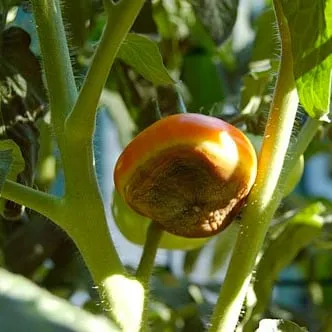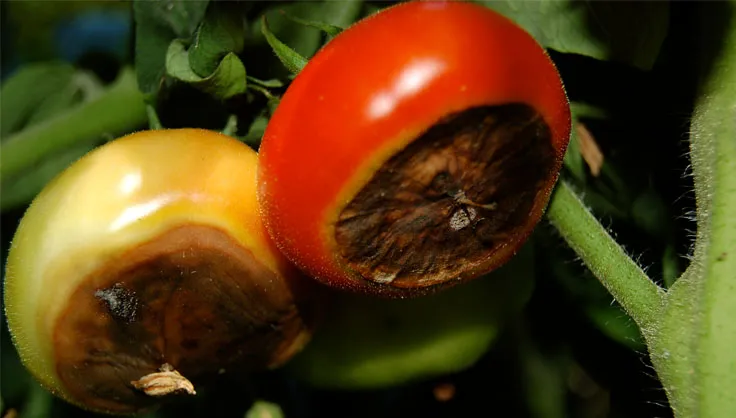What should I do to stop tomatoes from rotting on the vine?

The characteristic indication of blossom-end rot is a water-soaked patch at the blossom end of tomato fruits. This frequent garden issue is not a sickness, but a physiological ailment caused by a calcium imbalance inside the plant. It may be found in the fruits of peppers, squash, cucumbers, and melon, as well as tomatoes.

Blossom-end rot is most common when the growing season starts out wet and then becomes dry when fruit is setting. The earliest signs of damage show when the fruits are about half their maximum size. Water-soaked patches expand and become dark brown and leathery. These areas will eventually begin to rot, so the fruit should be picked and discarded.

A plant’s capacity to absorb adequate calcium for healthy growth might be hampered by a variety of reasons. They include soil moisture variations (too wet or too dry), an overabundance of nitrogen in the soil, root damage caused by cultivation, soil pH that is either too high or too low, cold soil, and salty soil.
Contents
Prevention and Control
- Keep regular soil moisture levels throughout the growth season. Water thoroughly once or twice a week when the weather is dry to hydrate the soil to a depth of at least 6 inches. Drip irrigation systems or soaker hoses are great for this.
- Prevent calcium deficiency with Tomato Rot Stop.
- Let soil to warm before planting in cold areas; cold soils decrease nitrogen absorption.
- Maintain soil pH at or near 6.5.
- Employ fertilizers that are rich in phosphorous and low on nitrogen, such as our GSC Organic Tomato Fertilizer.
- Add mulch, such as Red Tomato Mulch, to reduce evaporation and help keep soil moisture constant.
- Maintain garden records: You could find that certain crop kinds are more prone to blossom-end rot than others.
Related Questions
-
Why are my tomatoes going rotten on the vine?
Blossom-end rot is caused by a lack of calcium in tomato tissue. Calcium enters the plant via the roots, but it settles in one area of the plant. This implies that the rot may develop even when the soil, stems, or leaves are rich in calcium.
-
What can I use to prevent blossom end rot on tomatoes?
How to Correct Blossom End Rot?
- Watering on a regular basis. Maybe you’ve been too casual with your watering routine and let your tomatoes dry out while they were setting fruit. …
- Test Calciums Levels, and Adjust as Needed. …
- Check Soil pH and Correct as Needed. …
- Use a Tomato Fertilizer with Calcium. …
- Avoid Damaging the Roots.
-
What is a home remedy for tomato end rot?
Blossom end rot may be caused by a lack of calcium. Dissolve 4 tablespoons of calcium nitrate in one gallon of water. Fill a spray bottle halfway with the solution. Spray the tomato plants with the calcium nitrate when they begin producing new blossoms, applying the solution three times a week throughout fruit formation.
-
Does baking soda help blossom end rot?
There is also a DIY baking soda spray that instantly kills mildew, however mildew may recur and need another spray.





